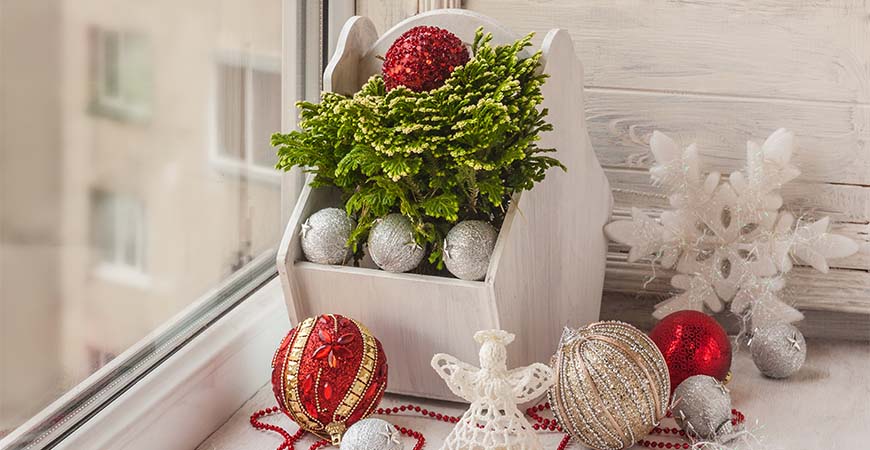
Pet-Safe Holiday Plants That Keep Your Home Feeling Festive
Mistletoe, holly, and poinsettias make a home feel festive and warm during the holiday season. However, these seasonal classics are among an unfortunately long list of holiday plants that are toxic to pets.
This doesn’t mean you have to choose between Fido and celebrating the season. On the contrary, there is a wide range of pet-safe holiday plants to deck your halls.
So, check out our guide below on which plants are poisonous, which ones are safe, and how to care for those that will keep your furry friends happy and healthy all season long.
A Quick Note on Holiday Pet Safety
The lists below are not meant to be all-encompassing. There may be plants in your home that aren’t typically associated with the holidays that could be poisonous, and even some pet-safe holiday plants may lead to unforeseen consequences for your pet.
Cats and dogs are naturally curious. So even if you’re bringing in a plant or flower that isn’t listed among our plants to avoid, consider keeping it in a place that would be difficult to reach.
If you’re concerned your pet may have ingested something poisonous, reach out to your vet or the ASPCA Animal Poison Control Center immediately. You may want to save the latter’s phone number — 888-426-4435 — in your phone, just in case.
Toxic Holiday Plants to Avoid
Amaryllis
Amaryllis is a particularly striking holiday plant. Its flowers are vibrant and stay true to the seasonal theme with petals that range from light pink to rich red.
However, amaryllis is also highly poisonous to pets. Every part of the plant contains toxins that could render your pet very ill, though the bulbs have an exceptionally high concentration.
Holly
Holly’s pointed leaves and red berries may be as synonymous with the holidays as mistletoe and Christmas trees, but they can be dangerous to pets and young children.
The berries themselves are poisonous and likely to cause various stomach issues, from excessive drooling to diarrhea and vomiting. In addition, their leaves can irritate mouths, throats, and the digestive tract.
If your pet eats holly, you may also notice them smacking their lips or vigorously shaking their head to relieve discomfort.
Ornamental Pepper
If you have any hot sauce fiends in your family, you likely know about capsaicin, the chemical compound responsible for a pepper’s heat. That compound is precisely why the ornamental pepper is on this list of poisonous holiday plants for pets.
Many of the same symptoms of eating something hot occur in pets as in humans. GI issues, including diarrhea and vomiting, are common.
Mistletoe
Standing under the mistletoe may lead to a kiss for you, but it’s just as likely to poison your pets. While severe toxicity typically only occurs after eating vast quantities, even a little bit can lead to gastrointestinal distress, such as diarrhea and vomiting.
While mistletoe is usually hung, thus keeping it out of reach of your pets, it can break apart or fall, making it easy to scoop up as a snack.
Another Quick Note on Christmas Trees and Poinsettias
Depending on what list you’re looking at, Christmas trees and poinsettias can appear on either the nice or naughty list for pets. That’s because while neither plant is necessarily poisonous, they can both lead to health issues.
Poinsettias, for instance, have previously been thought to be highly toxic. However, this has turned out to be somewhat inaccurate, though its sap can cause stomach issues in pets.
Additionally, as they grow, many poinsettias are sprayed with heavy amounts of pesticide. What is typically toxic to pests will also be harmful to your pets.
So, if you want to ensure your decorations only include pet-safe holiday plants, consider forgoing poinsettias or placing them entirely out of the reach of your pets.
Christmas trees can also be potentially hazardous. Lights and ornaments may look tasty to some dogs, but they aren’t food and shouldn’t be treated as such.
Curious felines may attempt to climb the tree, knocking it over and injuring themselves. Even if they escape unscathed, the falling tree could break precious ornaments or damage the surrounding area.
Finally, your pets may attempt to lap up some water at the tree’s base. However, this water is nasty stuff, and likely contains bacteria, mold, and fertilizer.
This isn’t to scare you off from participating in a common holiday tradition. Instead, use these pet-proofing tips to keep your tree and pets safe.
Pet-Safe Holiday Plants
Christmas Cactus
A suitable substitute for mistletoe or holly, Christmas cacti can add holiday cheer to any home without the potential dangers of other plants. Indeed, you’ll find that their vibrant flowers, which run from bright pink to deep red, and green, will easily fit into any seasonal decor.
A Christmas cactus is also easy to care for. Place them in an area with access to bright, indirect light and plenty of humidity. (So, a kitchen or bright bathroom would be ideal.)
You only need to water them when the top third of the soil feels dry, approximately every two to three weeks. Pruning back dead flowers and leaves will also help to extend their bloom.
As a bonus, Christmas cacti are easy to propagate. Plant a cutting in some moist soil, and they’ll take root within a few weeks, giving you additional plants for around the house or as a gift.
Frosty Ferns
If you live in a climate that doesn’t typically receive snow, frosty ferns can help turn your home into a winter wonderland. The white tips of their fronds resemble frost or light snowfall, hence their name.
These plants are typically considered safe for pets and don’t require much fussing to thrive. Place them somewhere that receives low to medium light and lots of humidity.
If your home isn’t particularly humid, you can boost the presence of moisture by placing them on a tray of pebbles and water or growing them in a terrarium. With the proper care, they can last years, meaning you can have a neverending holiday celebration.
They’re also ideal if you’re tight on space. Most frosty ferns grow to about eight inches, though they can reach up to a foot in good conditions.
Red Roses
If you don’t want to miss out on the burst of velvety red that poinsettias offer, consider classic red roses. They’ll fill your home with holiday colors and a loving warmth that’s hard to match with any other plant.
Red roses don’t just have to be purchased by the dozen from your neighborhood florist, either. They can be grown indoors, and their care tends not to be overly involved.
For the most part, you’ll want to keep your roses where they’ll receive several hours of direct sunlight. Then, you only need to water them when the soil feels dry to the touch.
If you live in an area with dry winter seasons, keep your potted roses on top of a bowl of pebbles and water to increase the nearby humidity.
White Orchids
White Orchids, specifically the Phalaenopsis species, are safe for pets and provide a delicate beauty to any home. You can use them as a centerpiece or accent to your other holiday decorations.
These orchids prefer a bright, well-lit spot. To prevent overwatering and root rot, place a small handful of ice cubes (two or three, at most) in their pot or give their roots a soak every week.
Not all orchids are safe for pets. So make sure you get one from the correct species. Other names for White Orchids include Moth Orchid or Moon Orchid.
Have A Festive and Safe Holiday Season With Pet-Friendly Holiday Plants
You don’t need to turn into a Scrooge to keep your pets safe during the holidays. Instead, toss out those holiday plants toxic to pets and choose plants, flowers, and ferns that are considered pet-safe.
For more guides, tips, and advice for keeping your home looking festive, warm, and welcoming all holiday season long, make sure to bookmark our AskWetAndForget.com blog!














